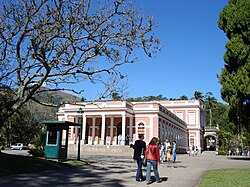Petrópolis
This article needs additional citations for verification. (February 2012) |
Petrópolis
Município de Petrópolis | |
|---|---|
 | |
| Nickname: The Imperial City | |
| Motto(s): "Altiora Semper Petens" (Latin for "Always seeking higher things") | |
| Country | Brazil |
| Region | Southeast |
| State | Rio de Janeiro |
| Government | |
| • Prefeito | Rubens Bomtempo (PSB) |
| Area | |
| • Total | 795.798 km2 (307.259 sq mi) |
| Elevation | 838 m (2,749 ft) |
| Population (2010) | |
| • Total | 295,917 |
| Time zone | UTC-3 (UTC-3) |
| Website | www.petropolis.rj.gov.br |
Petrópolis (Portuguese pronunciation: [ˌpeˈtɾɔːpʊʎiʃ]), also known as The Imperial City of Brazil, is a town in the state of Rio de Janeiro, distant 68 km from the city of Rio de Janeiro.
Nestled among the forested hills of the Serra dos Órgãos, in the valley of the Quitandinha and Piabanha rivers, Petrópolis is a popular summer holiday spot. Besides the climate and surroundings, the main attraction is the former Summer Palace of the second Brazilian emperor, which is now the Imperial Museum, specializing in Imperial history and memorabilia.
Petrópolis is home to the National Laboratory for Scientific Computing (pt: Laboratório Nacional de Computação Científica (LNCC)), a research unit of the Ministry of Science and Technology of the Brazilian Federal Government.
History

The town's name ("city of Peter") honors Emperor Pedro II, the nation's second monarch and son of Pedro I. The city was the summer residence of the Brazilian Emperors and aristocrats in the 19th century, and was the official capital of the state of Rio de Janeiro between 1894 and 1902.
The town's origins can be traced to Bernardo Soares de Proença, who between 1722 and 1725 opened an alternative route between Rio de Janeiro and Minas Gerais, across the Serra da Estrela. While traveling to Minas Gerais along this route, Emperor Pedro I found the region's climate pleasant, while staying at the farm of Correia, a Catholic priest. As the priest's sister and heiress refused to sell his property, the Emperor bought in 1830 the neighboring one, the Córrego Seco Farm. He had his Summer Palace built there, but never saw it finished, because he stepped down from the throne, on April 7, 1831.[1] Other Brazilian aristocrats eventually followed suit. Pedro's Palace is nowadays the Imperial Museum, one of the main attractions of the "alpine city" of Petrópolis, together with the Cathedral of Saint Peter of Alcântara, the Crystal Palace and the House of Santos-Dumont (pt: Museu Casa de Santos Dumont). The "Imperial City" became in due time home to artists, intellectuals and celebrities, and by the twentieth century, one of the main tourist attractions in the country.
German farmers from the Rhineland were encouraged to immigrate and to settle on the Emperor's outlying lands, to help give the Palace a charming urban setting. The settlement of Petrópolis was founded on March 16, 1843, being promoted to city in 1857. The road connecting the city to Rio de Janeiro was opened in 1910 and paved in 1928. The urban design was carried out by Major-Engineer Julius Friedrich Koeler.
On a visit to the Philadelphia Exposition of 1876, Pedro II was impressed by Alexander Graham Bell's new invention, the telephone, and had a line connecting his Summer Palace to his farm headquarters.
Even after the establishment of the Republic and the exile of the Imperial family in 1889, the city continued to play a significant role in Brazilian history. It was a frequent choice as summer residence for presidents of the republic, who lodged at the Palace of Rio Negro. In 1903 the Rio Negro Palace saw the signing of the Treaty of Petrópolis with Bolivia, which gave Brazil the Acre territory. On August 15, 1947, the Organization of American States opened their Conference for the Maintenance of Peace and Security in the Continent, from which derived the Interamerican Treaty for Reciprocal Assistance.
Sister cities
Petrópolis is sister city of:
 Blumenau, RJ
Blumenau, RJ
Climate
Petrópolis has a subtropical highland variety of the Oceanic Climate (Köppen climate classification Cfb) caused by elevation with humid summers. The rainfall is approximately 2,400 mm (94 in) per annum.
The temperature is mild. The annual average is around 19 °C (66 °F). In warmer months, the average temperature is 23 °C (73 °F) and the average of the coldest month is 15 °C (59 °F). According to the National Institute of Meteorology (pt: Instituto Nacional de Meteorologia), the lowest temperature recorded was −0.7 °C (30.7 °F) on August 2, 1955 and the highest temperature recorded was 36.6 °C (97.9 °F), on November 6, 2009.






